Contents
What are Diabetic Ulcers?
These are usually open sores occurring in the bottom of the feet. According to experts, around 15% of diabetics will develop diabetic ulcers at some point in their life. Many people suffering from it get hospitalized due to complications, and some even have to go through amputations. But you can prevent the development of diabetic foot ulcers if you are taking early precautions.
Can you tell me one area of the human body system that diabetes leaves unaffected? Trust me, you won’t find any. So, diabetes pushes you closer to ulcers and sores as well. It’s not that ulcers happen only to people with diabetes. But yes, there is no denying that people with diabetes are more prone to ulcers and sores.
Causes of Diabetic Ulcers
Some of the most causes of ulcers in people with diabetes are:
- Poor blood circulation
- Venous insufficiency
- High blood sugar (hyperglycemia)
- Nerve damage
- Irritated or Wounded feet
Poor Blood Circulation
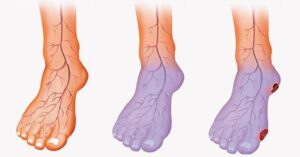
Diabetes affects the flow of blood in your body also. This condition of poor blood flow or poor blood circulation all through the body is called peripheral vascular disease. With the lack of good blood flow, it becomes tough for your sores, cuts, and injuries to heal. So if you catch any infection that is taking time and is not being healed because of poor blood flow, then it might develop into ulcers or gangrene. These are the serious conditions wherein the tissues of the affected areas die due to a lack of blood.
The medicines you take for diabetes management also affect blood circulation.
Venous Insufficiency
The damage in the veins of the leg causes slowing of blood circulation. Due to this congestion is caused and ulcers develop.
High Glucose Levels
Constant high glucose levels affect your immunity. This is why the healing power of your body is eventually affected. Because you fail to manage your blood sugar levels, you are more likely to get infected. The over sweetness in your blood is an invitation to all sorts of infections, which further gets even more complicated and impossible to treat.
Nerve Damage
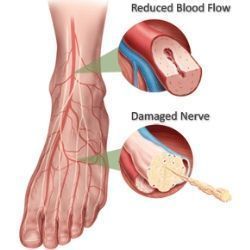
Nerve damage that happens in the body if you have diabetes. Frequent fluctuations in blood sugar levels affect the nerves adversely throughout the body. The primary target is our feet and legs. What happens is that you get a small injury or cut in your leg, but due to nerve damage in that area which further leads to loss of sensation and feel, you are not able to feel the pain. As a result, the small wound or cut results in ulcers, or diabetic ulcers.
Peripheral Artery Disease
Since diabetes damages blood vessels, inflammation and hardening of the arteries (atherosclerosis) occur.
Symptoms of Diabetic Ulcers
Experts say that contact immediately to your physician or your podiatrist if you face any of the symptoms of a diabetic foot ulcer. If you are not able to manage your blood sugar levels and you notice any of the below symptoms, please seek medical help:
- Swelling
- Redness
- Open lesions
- Cracks
- Sores
- Foreign material stuck in your foot
- Pus
- Odor
- Pain in your ankle
Types of Foot Ulcers
Ulcers are categorized on the basis of their appearance and their location. The borders and skin surrounding the ulcers also tell you which type of ulcer it is.
The three most common leg ulcers are.
- Venous stasis ulcers
- Neurotropic
- Arterial (ischemic ulcers)
Venous Stasis Ulcers
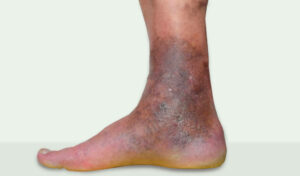
This type of foot ulcer is common in people who have suffered from leg swelling, varicose veins, or blood clots, either on the surface level or somewhere deep in the legs.
Venous stasis ulcers occur below the knee, usually noticed on the inner of legs, that is, right above the ankle. In color, they may be red, or sometimes green, covered in yellow fibrous tissue, or have yellow discharge as well. The shape is usually irregular. In touch, they might feel hot or warm. Also, they can feel tight in touch-based on the level of swelling.
Neurotrophic Diabetic Ulcers
Usually, you can find neurotrophic ulcers at the increased pressure points, and at the bottom of the feet. However, in some cases, it can be found occurring anywhere on the foot. The color of the base may appear red, brown, pink, and black. The surrounding of the skin is hardened, and a bit punched out.
Mostly, neurotrophic ulcers occur in a person with diabetes. Therefore, it becomes essential for people with diabetes to take extra care of themselves. They should never move around barefoot.
Arterial (ischemic) Ulcers
It may appear on:
- On the heels
- On Tips of toes
- Between the toes
- In the nail bed
Arterial ulcers are yellow, brown, black, or grey in color. Usually, you don’t find bleeding in this case. This in particular is very painful. There can be swelling, redness, and punching out of the surrounding area. There can also be irritation based on the swelling and redness of the base of the ulcer.
Risk Factors of Diabetic Ulcers
Above any other factor, diabetes is the most common one causing foot ulcers. Further, if you are a diabetic, and you comply with any of the factors given below, the chances of you getting affected are even higher. The risk factors are:
- Uncontrolled diabetes
- Being overweight, or obese
- Poor blood circulation
- High cholesterol levels
- Wearing unfit shoes
- Excessive alcohol drinking
- Smoking
- Aging
- Walking barefoot
- Poor hygiene
- Untrimmed nails
- Kidney disease
- Heart disease.
Diagnosis of Diabetic Foot Ulcer
If you are a diabetic and you come to the periphery of the above-mentioned risks, please be careful. Seek medical help to avoid any extremities.
Once you reach your doctor, he would look for underlying factors. He would inspect your toes, foot, and toenails for:
- Blisters,
- Cuts,
- Scratches,
- Ingrown toenails
Furthermore, he would examine your foot for proper blood flow. The doctor can also ask you to walk to find the distribution of your weight across the bones and joints of the feet. In addition, the doctor will also look into the shape your feet turn into. If there is any misalignment, the ulcer will reach its extreme.
Above all, your doctor will go for certain testing and scanning for finding out an accurate condition of the ulcer. The tests or the scans include:
X-ray for Diabetic Ulcers
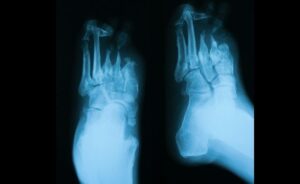
X-rays can be recommended for the doctors to assess changes and the misalignment of the joints and bones of the foot. Diabetes also leads to bone loss and X-ray detects this also.
Loss of bone mass makes the bones weak and as result, small fractures and other injuries keep on occurring repeatedly. This condition is called Charcot’s foot.
MRI Scans
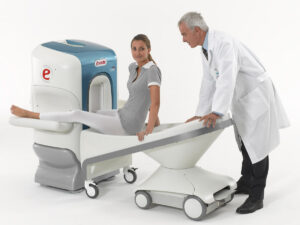
MRI scans are a bit more powerful test. It gives you a detailed picture of the scanned area. Using magnetic fields and radio waves, it creates computerized and three-dimensional images of even the soft tissues of the body. The images can also indicate inflammation, which surely can be a sign of inflammation.
Blood test
Your doctor may recommend you a blood test if he finds signs of infections such as redness, swelling, and warmth in the affected foot. Within a week, the test results will be made available to you.
Treatment of Diabetic Ulcers
You need to be very careful with your foot ulcers. The initial goal in the treatment of foot ulcers is to acquire healing as fast as possible. Because the chances of lowering the infections are possible only when the healing has begun.
- The treatment for diabetic foot ulcers can be:
Prevention of infection - Off-loading
- Debridement
- Medication
- Managing blood sugar levels
- Surgeries
Let’s discuss them one by one.
Prevention of Infection
It’s not important that all ulcers have infections. However, if there is any sign of it, your podiatric physician will take preventive measures to stop the spreading of infections. Because it can lead to hospitalization if not taken care of.
The preventive measures the doctors would ask you to take are:
- Control on high blood sugar levels (hyperglycemia)
- Cleanse wounds and keep them bandaged.
- Do daily dressings of the wound
- Do not walk barefoot
Off-loading
Don’t walk because the more pressure is on your foot, the worse they will get. The infection spreads even more if you don’t give rest to your foot. This is called off-loading.
Earlier, it was believed the more air will get into the wound, the more it will heal. But it is against the process of healing. Now experts suggest that the healing will be done properly if they are kept covered and moist. So, the doctors have certain items to wear in order to protect your feet. They are:
- Shoes that are specially designed for people with diabetes
- Compression wraps
- Foot braces
- Casts
- Shoe inserts that help to prevent corns and calluses
Debridement
Once you notice an ulcer or some change on your skin, talk to your doctor immediately. Your doctor will try to remove the unhealthy tissue, the cause of the occurring wounds and ulcers. He will ask you to keep your wounds clean so you don’t develop any infections.
Medications and Dressings
If you want appropriate management for your wound, dressings and a proper bandage are a must. In addition to it some medication would also be required. The medications can range from usual saline to some advanced and updated product for dressing. This includes growth factors, ulcer dressings, and skin substitutes.
These products have proven to be Highly Effective in the healing process of diabetic foot ulcers.
Blood sugar Level Management
Be it any complications of diabetes, the first and foremost precaution or step your doctor would ask you to take is to maintain your blood sugar levels close to normal. You might have heard doctors saying the treatment is not possible even to begin if your blood sugar levels are keeping high. So is the case with Diabetic foot ulcers. Your Endocrinologist will help you accomplish normal levels of blood sugar so that your podiatrist can further the treatment procedure for ulcers.
Surgical Operations
When your answers on diabetic ulcers have not been affected by infections it is possible to treat them without any surgery. but when this happens and your bones are immensely affected by infection proper surgical management is required. Some of the surgical processes might include:
- removal of the affected area through shaving or excision of bone(s)
- corrections of deformities such as hammertoes, bunions, corns, or bumps
Prevention of Diabetic Ulcers
Daily Foot Inspection
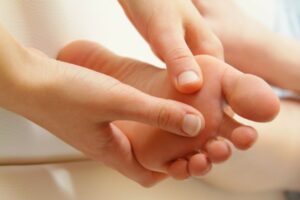
Experts and surgeons suggest people with diabetes be very careful with their foot health. It is advised to daily inspect your both feet for any cuts, scratches, and ingrown toenails. It’s important to have a lock at the bottom of each foot daily. In any case, if you are not able to do so, use a mirror or ask someone from your family members to check for it. Also, the redness, swelling, and feeling of vomit can be the signs of infection so if you notice these changes seek help.
Cleansing & Trimming of Toenails
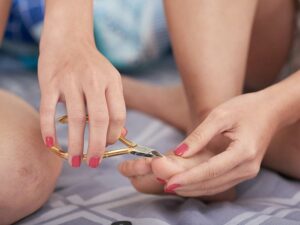
Wash your feet every day. Use warm water to do so. But never soak your feet. You just need to wash them, make them completely dry, and don’t forget to apply lotions. Whenever needed, trim your toenails. Don’t wait for the time to grow them long enough to cause cuts.
Proper Footwear

Use diabetes-friendly footwear and socks. While shopping for shoes and socks, you need to be a little more attentive if you are a diabetic. Go for full coverage shoes with more depth in the toe box. Never step out barefoot. However, you should not move barefoot even when you are indoors.
Weight Loss

There is a relationship between the pressure you provide on the feet and the developing ulcers. The increased the pressure is the more chances there are for you to develop such a problem. This happens because when you are overweight and you wear shoes or any footwear the friction between your feet and the shoes is more, which leads to blisters and cuts. Therefore, there is a need to reduce your weight, especially when you are diabetic.
Tobacco Prohibition

Cigarettes and other tobacco products have chemicals in them that slow the process of healing. So if there is any chance of you getting affected by Diabetic foot ulcer tobacco will increase the level of its severity. On the other hand, doctors say that tobacco products affect the circulation of blood, or flow of blood in the legs and feet causing higher risks for ulcers in these areas.
Conclusion
Here we have reached the end. All you need to know is that it is your body and it will be you taking care of it lifelong. You need to be very sure about the impact that certain edible things are going to put on your body. The wisest option is to make a balanced diet chart for yourself and make a note of everything that helps you in a positive manner. More importantly, you should be aware of the methods by which you can monitor your sugar level timely. Hope you ended up having a productive time reading the above article about blood sugar levels.
Do you want to get rid of diabetes? Join our online diabetes consultation program and reverse your Diabetes naturally through lifestyle changes such as a Personalized Diet plan, Exercise, dieticians, and health coaches.


